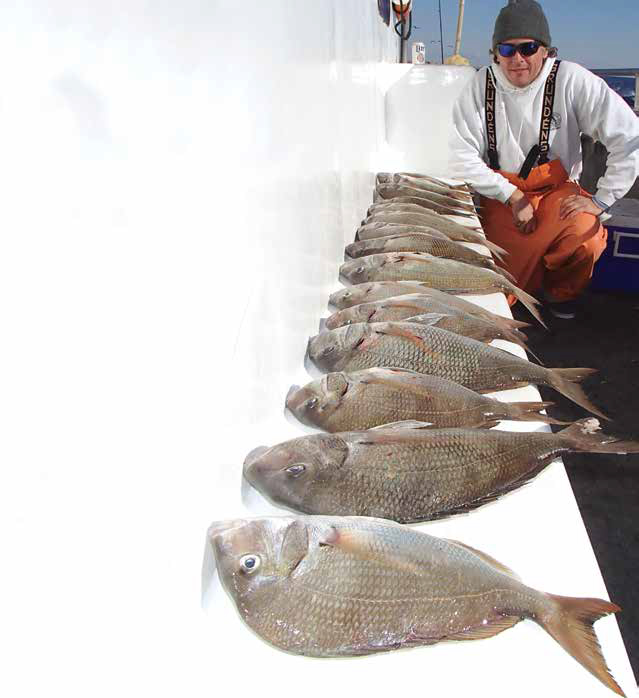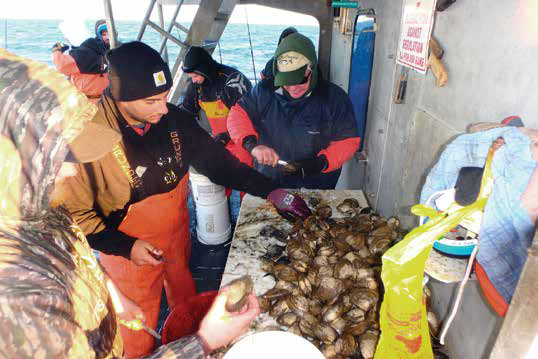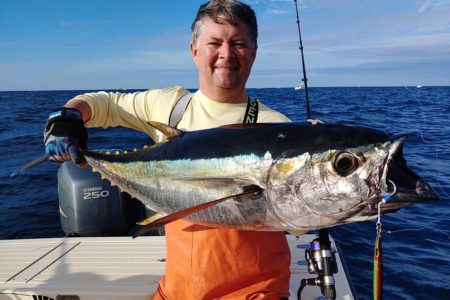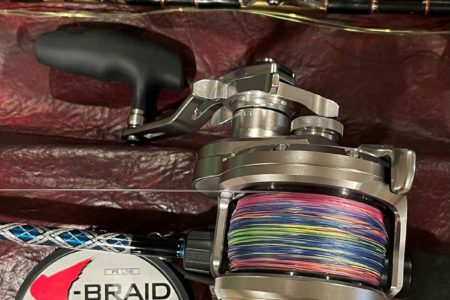
A slab-side Shangri-La with plate-sized porgies spreading across the offshore grounds!
On a 24-degree, hand-numbing late December day, the 85-foot Dauntless party boat out of Point Pleasant, NJ steamed 15 miles east through 4-foot seas toward the Shark River Reef. Capt. Butch Egerter set the double anchors, blew the horn loud signaling lines in. One plunk after another, 40 baited hooks and sinkers bombarded the reef from above.
It wasn’t even a three second count before the telltale rap-rap-rap of a porgy hit my clam bit and was decked. Then two more. Then 40 more. All along the rail in succession, rods bent over, and porgies were being slung over the rails in unison.
New York and Massachusetts anglers are used to that type of scup action, but that type of porgy pounding has not happened in Jersey for quite some time. In the last four years, porgy fishing has made a serious rebound in the Garden State’s waters big time, with more reports coming even further from the south towards Delaware as the stock and range grow by the day.
Porgy Passages
“We’ve definitely seen a resurgence of porgies on the inshore grounds in recent years,” said Capt. Butch. “It’s been nice to have them around as guys can fill coolers with them on the days sea bassing or ling fishing is slow.” Porgies, aka scup, will follow water temperatures of 54 to 77 degrees to feed comfortably. Generally, during the months of July through November, you can find porgies clambering about the inshore rockpiles, reefs and wrecks that lay within 3 to 15 miles off the coast.
Once December hits, the pork chops start making a migratory move offshore, stopping by the 15- to 30-mile wrecks and rocks and by January, February and March, the scup are colonizing the offshore rockpiles inside the Wilmington and Lindenkohl Canyons, in and around 200 to 300 feet of water, as the heart and late end of winter comes around. Last year, porgy fishing was bananas off the Sandy Hook Reef, Farms and Mud Hole area during July and August while October through December some big slabs were hanging tough on the Shark River Reef, providing plenty of action on “dinner plate” specials as some pork chops hit the 4-pound mark out there.
In February, look to hop on offshore trips out to the 50- to 80-mile rocks to find scup. Headboats such as the Big Mohawk, Dauntless, Skylarker, Big Jamaica, the Jamaica II, the Paramount, Voyager, and the Gambler run trips in January and often through February, conditions permitting, for ling, cod, blackfish, and yes, jumbo porgies – get more details on who’s sailing now in the Report Section of this month’s edition of The Fisherman!
Slab-size Strategies
Off New Jersey in particular, hard bottom structure reigns supreme for porgies. Submarine rockpiles and glacial boulder fields are prime turf to attract porgies, but they also gravitate to wrecks. Some wrecks can be high profile, and if you aren’t getting hits near the bottom, feel free to reel in a good 10 to 20 feet to see if they are staging up above the wreck or around the higher points of the structure.
A three-dropper rig is best employed for porgy fishing, giving you plenty of action when schools are thick. When specifically targeting porgies, hook size is a main concern, and you have to get rid of the large cod and blackfish hook mentality and lance on size #1 to #2 baitholder hooks. There are two schools of thought when it comes to the rigs however. “Usually a three-hook dropper is best, as porgies amass by the thousands, so the more hooks down the better,” said Egerter. “Some guys only have a 3-inch dropper with the hook looped on it, but I like to use longer 12-inch snelled hooks to loop onto the dropper, as porgies seem to hang themselves better when they rap at it and make a little run. The extra long snell hooks the porgy mouths better.”

You can put a few bells and whistles above the hook in the form of one small red or green bead or small squid skirt if you want, but don’t overdo it. Though considered bottom fish, scup notably feed above the seafloor. “Porgies can be right on the bottom, but most of the action lies about 3 to 10 feet above,” said Butch. “I always tell guys to let the rig hit the bottom then reel up four or five cranks and let the baits hang in the water column.” Baits need to be bite-sized for the pork chops’ small grunty mouths. Leave the gobs of clams on deck and use tiny half inch cuts of clam tongue on the hook. One bit will suffice but you can lump two or three on for insurance. In a pinch, you can slip on Fishbites or 2-inch Berkeley Gulp! grubs for baits.
Bottom Brawlin’ Basics
Rods should run 6-1/2 to 7 feet, moderate action and have a fast tip. Match it with a 16 to 20 class Torium 20 reel, spooled up with 50-pound braided line. Rig wise, a three-dropper rig consisting of 40-pound Trik Fish mono leader, tied with a 75-pound barrel swivel, then three equidistant droppers tied 16 inches apart with an overhand knot at the end to loop on a bank sinker.
Tie your rig on via the barrel swivel directly to the braid. The braided line gives you a decided advantage as porgy hits are transferred directly to the rod tip, allowing you to swing immediately at the quick-rat-tat-tat bait stealing hits. It may sound ridiculous to say this about a member of the grunt family, but you do not want to horse porgies in. Their tenacious fight will no doubt put on some super head shaking runs that can dislodge a hook if there is too much forced pressure after the hookset.
Scup may be small in stature, but they’ve definitely got some fight in ‘em. Reel up at a moderate, steady pace as a triple hook of porgies will no doubt be taking you all over the place. Be prepared to reel up to the tip and swing them over the rail, or if they are truly large, wait for the net.
Targeting “poke chop” size porgies over the 3-pound mark is kind of a crap shoot, with the key being to weed through the nips of the smaller ones first to allow the big ‘uns to get in on the action. Some tactics include lancing two to three clam bits on the hook as the little poke chops will snip at the bits, attracting attention from larger ones to come in and do the clean-up job. Strangely, I’ve found that a slow jig of the rig gets the attention of large porgies, in that I drop the rig to the bottom, then reel up four to five cranks, then slowly lower the rig and then slowly raise the rod again, in a sluggish, slow motion jig.
Supersized scup seem to hone in and chase down the fluttering bait on the drop and get to it before the little ones do. One particular trip on the Dauntless with Sean Reilly, we absolutely lambasted the fish using this technique, scoring our 50-fish limits and landing 25 that were over the 3-pound mark.
Let’s face it, February is a rough month to get through, but limit catches of slab-sized scup are out on the offshore rockpiles now, so there’s no excuse to be sitting indoors.
| NJ/DE FACTS: RULES & REGS |
|---|
|
In New Jersey, the porgy season is open from January 1 to February 28, then the season shuts down until it reopens again on July 1 and runs through December 31. There is a 9-inch minimum size and a 50-fish bag limit. In Delaware where there’s less of a fishery (though truth be told the stock has been expanding in recent years), the porgy season is open year-round with an 8-inch size limit and 50-fish bag limit. Don’t forget, 2017 is underway so it may be time to update your license, registration or FIN. In New Jersey, it’s free to fish in state coastal waters but you must register every year. Go to www.saltwaterregistry.nj.gov. In Delaware, the fee for an annual resident fishing license remains $8.50; the non-resident fee is $20 per year, while the seven-day tourist license is $12.50. Each of these license options entitles the holder to fish in any of Delaware’s waters, as well crabbing and clamming. For more information or to obtain a Delaware fishing license call 302-739-9918. |



